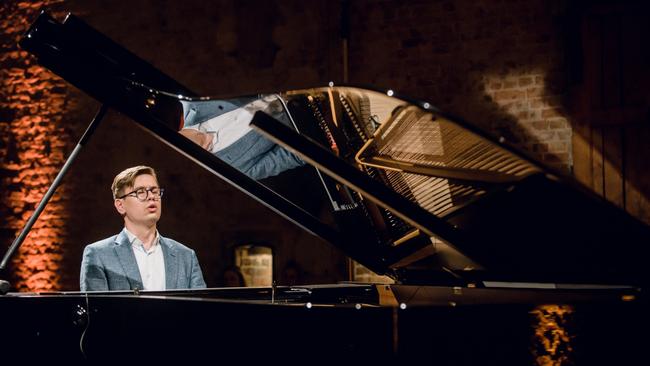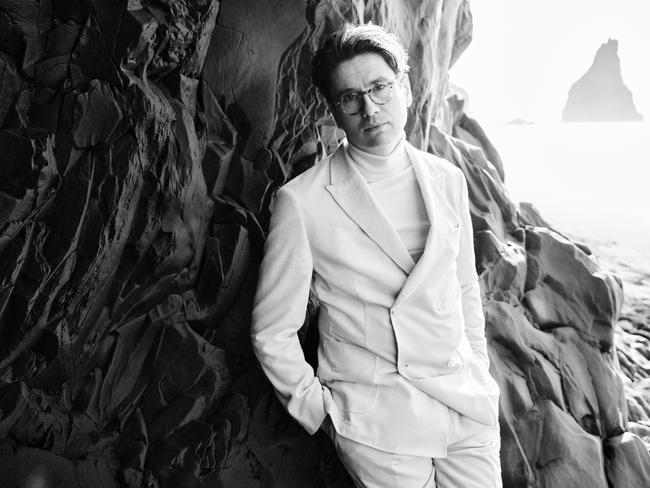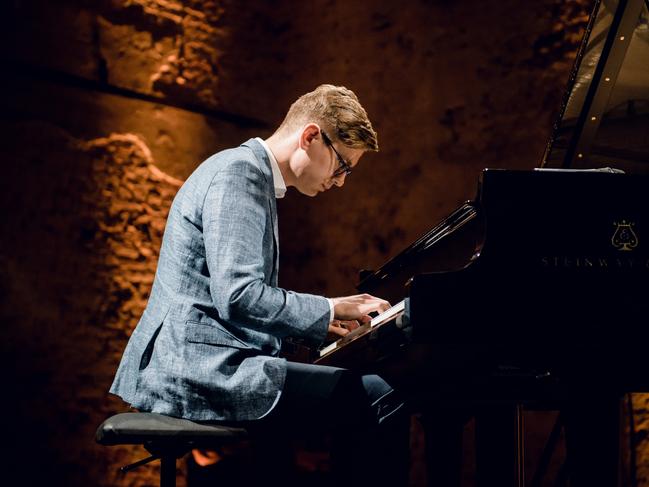Vikingur Olafsson to make Australian concert debut at Adelaide Festival
Icelandic pianist Vikingur Olafsson wanted to see what would happen if he spent a year travelling the world with a suitcase and the Goldberg Variations.

Vikingur Olafsson certainly had a sense of adventure when he decided to travel the world with just a suitcase and the Goldberg Variations. The Icelandic pianist has attracted a cult following for his refreshing approach to the keyboard music of JS Bach. With his current tour, the idea was to perform the complete set of the Goldberg Variations on 88 separate occasions – representing the number of keys on a modern piano.
As it happens, his schedule has expanded to about 95 concert dates across both hemispheres including, in March, his long-awaited Australian debut.
“The idea was, and is, to have a year away – just with a suitcase and with my beautiful Bach score, and to see what happens,” Olafsson says.
“It’s almost like a conceptual thing. When you spend this much time with what, to me, is history’s greatest keyboard work, how many ways can you find with the Goldberg Variations while being completely sincere and never doing something for the sake of doing something, but rather allowing it to spring from a natural source? That is the task.”
Olafsson, 39, is speaking on a Zoom call from his home in Reykjavik, on a morning when it is -6C outside and snowing. He has had a few weeks at home for Christmas and admits he has enjoyed the break from touring. When we speak, he has just done the morning school run with his two young sons.
Olafsson’s playing has been described as volcanic. Indeed, Iceland’s active Fagradalsfjall volcano, 40km from Reykjavik, had another eruption days before this interview. But that doesn’t really describe the invigorating energy and hushed beauty he achieves at the keyboard. Olafsson is an artist in the fullest sense of the word, paying attention to every detail of his performances and recordings, from voicing the piano to the placement of microphones and even the photography and videos. With his glasses and turtleneck sweaters he can look quite solemn and serious, but in conversation he is talkative and takes evident delight in discussing his musical projects.
The Goldberg Variations have a rarefied status in the keyboard literature. Written originally for harpsichord – and, so the legend has it, to beguile the time for a Russian count with insomnia – the Goldbergs comprise a graceful opening aria and 30 variations that spring from its harmonic progression, after which the aria is played a final time. The variations were composed “for connoisseurs, for the refreshment of their spirits”, and include canons, overtures, fugues, dances and other musical forms of the 18th century, always displaying Bach’s masterful powers of invention.

Olafsson says a spirit of improvisation must be part of the performance, even of such a canonical work.
“You have to embrace the openness of Bach, and the dual nature of (his music): the most maximal structure in keyboard history and, on the other hand, the most minimal when it comes to the instructions,” he says.
“It’s a huge paradox, where you have to take a very active, creative role. There’s no escaping it. I think that’s one of the reasons why so many people stay away from Bach, because he is so daunting. You have to have kind of a creative confidence – and also to accept that people might hate what you’re doing, and that’s OK.”
One critical aspect of any performance of the Goldberg Variations is tempo. Olafsson says he may decide to play a variation at a slightly different tempo than before, or find that, over a series of concerts, the music is leading him in a certain direction.
“That is very exciting as well,” he says. “One thing I was worried about was that I would get tired of the Goldberg Variations after 40 performances – I think I have played 45, I am basically halfway through – and I am honestly not tired at all. I’m not just saying it, I love it and I don’t tire of it. I am looking forward to it every time, because of the unexpected that the piece brings.”
For listeners yet to experience Olafsson’s Goldberg Variations in concert, his recording of the set, released last year, is instructive. After the graceful and limpid aria, Olafsson’s entry with the first variation comes as a surprise, because he plays it bracingly fast. It invites comparison with Glenn Gould’s famous 1955 recording of the Goldbergs. Gould plays the first variation at 45sec, without repeats; Olafsson does the repeats and clocks in at 1min 31sec.
He asks himself what is the effect Bach wanted to achieve.
“You have this simple but profound aria, and then you have Variation 1 – and the writing couldn’t be more different,” he says. “He seems to be splashing cold water into our faces and just saying, ‘You have no idea what you have signed up for’.
“I like that idea of waking up early with the piece, and let’s take this journey. When you start a journey, you are full of energy, and you are ready for it – and I do sense it as a journey. I wanted it to be a very fresh and optimistic start. There is something about the nature of the playful offbeats in that variation – the rhythmic invention on top of the virtuosic writing – that seems to exude joy. My current way of being happy is that.”
Olafsson has become a genuine star in the classical music world – so much so that the cover of his Goldberg Variations album dispenses with the patronymic and names him simply as Vikingur (pronounced “Vee-kingur”). His recordings – which now include recitals of Philip Glass, Bach, Mozart and a delicious pairing of Debussy and Rameau – have earned him multiple awards.
Like other performing artists, his touring activity was disrupted by Covid. He was to have been artist in residence at the Adelaide Festival in 2020, right at the start of the global pandemic. He will be making his belated Australian debut with concerts in Adelaide, Sydney and Melbourne, including performances of Ravel’s G-major concerto with the Sydney Symphony Orchestra.

He started out as an independent artist, recording his own piano recital discs and working with his friend and musical collaborator, Christopher Tarnow. In those days he would write the liner notes, package the CDs and do the mail-outs from his kitchen table.
“I had absolutely no money, and it was slightly cheaper to pack them myself,” he says. “Putting them all into the plastic was so much work, and doing the distribution myself. I remember going to the post office a billion times – actually we didn’t sell that many – because someone had ordered the CD in Arizona or indeed Australia.”
He has since been signed with Deutsche Grammophon, but he continues to work with the same small team – “it couldn’t be any smaller” – of Tarnow as his producer and sound engineer, and piano technician Michel Brandjes. They make the recordings using Steinway Model D concert grand pianos at the Harpa Concert Hall in Reykjavik.
Olafsson explains how he and his collaborators achieve the incredibly intimate sound on his recordings.
“The Goldberg recordings had microphones just above my head, to give the listener almost the feeling that you are sitting on the piano bench,” he says. “We are going for a considerably closer sound than almost anybody else, which makes it horribly difficult sometimes – every microdecibel is heard, and the control of the touch and the evenness of the piano is of such importance that it cannot be overstated. I opted to have a very bright piano, but to play it as sensitively as I could. What that gave me was the added beauty of overtones – but it’s also very difficult to get those overtones if you are playing loud. So you have to play so soft, and then you get the nuance to the sound.”
This week, Olafsson has been giving concerts in North America, but he will return home to Reykjavik next month for his 40th birthday, on February 14. Of course, he’s planning to spend his big day at the Harpa Concert Hall, playing the Goldberg Variations.
What are his artistic or personal goals with this music?
“There is a reason I call this history’s greatest keyboard work,” he says. “It is like an encyclopaedia of how to think and dream at the piano – and people are drawn to the idea of the journey, and how it can reflect your own life, your own existence … So this very abstract work can become very subjective.
“The external goal is to bring this message to people around the world, and I think it will bring something to people’s lives.
“My internal goal for myself is to get better at what I do, and to become a better musician in every sense – physical and metaphysical. To become deeper and more fine-tuned, because this piece requires that of you.”
By the time his global Goldbergs tour wraps in June, at Schloss Elmau in the Bavarian alps, he will have given almost 100 concerts across six continents, and performed Bach’s great work for solo keyboard at such storied venues as Carnegie Hall in New York, the Philharmonie in Berlin, Suntory Hall in Tokyo, and the Sydney Opera House. And he may not be finished yet.
“There is something extra added to the Goldberg Variations that is hard to explain,” he says. “They become almost like a courtroom – they expose the truth, they expose who you are, what your limits are, but also your strengths.
“Which is why, at the end of the tour, I’m pretty sure I’m going to record them again, for myself, and let’s see if I release it. But I want to have that document at the end of the tour, so I can think about it in five, 10 years – what really happened that year?”
Vikingur Olafsson plays the Goldberg Variations at the Adelaide Festival, March 15 and 17; Sydney Opera House, March 18, and; Melbourne Recital Centre, March 25. He performs Ravel with the Sydney Symphony Orchestra, March 20-23.
